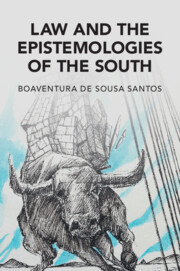Book contents
- Law and the Epistemologies of the South
- CAMBRIDGE STUDIES IN LAW AND SOCIETY
- Law and the Epistemologies of the South
- Copyright page
- Contents
- Preface
- Abbreviations
- Part One The Tragic Optimism of the Law: THE END OF A STORY
- Part Two Epistemologies of the South and the Law
- Part Three The Abyssal Law under the Mode of Abyssal Exclusion
- Eight Lawfare: A Long History
- Nine Colonial Law and Imperial Law
- Ten Colonial Legal Duality: The Creation of Legal Codes for Indigenous Populations
- Part Four Real Legal Utopias: Interrupting the State
- Part Five Real Legal Utopias: Interrupting the Law
- Part Six Real Legal Utopias: Interrupting Hegemonic Human Rights
- References
- Index
- Cambridge Studies in Law and Society
Nine - Colonial Law and Imperial Law
from Part Three - The Abyssal Law under the Mode of Abyssal Exclusion
Published online by Cambridge University Press: 07 August 2023
- Law and the Epistemologies of the South
- CAMBRIDGE STUDIES IN LAW AND SOCIETY
- Law and the Epistemologies of the South
- Copyright page
- Contents
- Preface
- Abbreviations
- Part One The Tragic Optimism of the Law: THE END OF A STORY
- Part Two Epistemologies of the South and the Law
- Part Three The Abyssal Law under the Mode of Abyssal Exclusion
- Eight Lawfare: A Long History
- Nine Colonial Law and Imperial Law
- Ten Colonial Legal Duality: The Creation of Legal Codes for Indigenous Populations
- Part Four Real Legal Utopias: Interrupting the State
- Part Five Real Legal Utopias: Interrupting the Law
- Part Six Real Legal Utopias: Interrupting Hegemonic Human Rights
- References
- Index
- Cambridge Studies in Law and Society
Summary
In this chapter, I argue that during the period of historical colonialism, colonial law consisted of two bodies of law separated by an abyssal line. When speaking of colonial law, one has to have in mind the law issued or accepted by the colonial power to apply in the colonies and govern their relations with the metropolitan centre. In this sense, colonial law consisted of two bodies of law. The first was the set of legislation (court decisions and administrative measures) emanating from the metropolitan government or colonial administration, to be applied in the colonies and in their relations with the metropolitan government. The second referred to laws and regulations that specifically applied to those sectors of native populations that were not “civilised” (the vast majority) or, in other words, those that had not been assimilated into European values, culture, manners and tastes. Both offered striking contrasts with the body of law that applied on metropolitan soil. The crucial topics that separated metropolitan and colonial law: a racial property regime; labour as a branch of criminal law; extreme punitive justice; formal or informal systems of apartheid grounded in settler or white supremacy; suppression or instrumental manipulative recognition of indigenous law. These topics show that metropolitan and colonial legality were (are) the two sides of modern abyssal law.
Keywords
- Type
- Chapter
- Information
- Law and the Epistemologies of the South , pp. 239 - 268Publisher: Cambridge University PressPrint publication year: 2023

